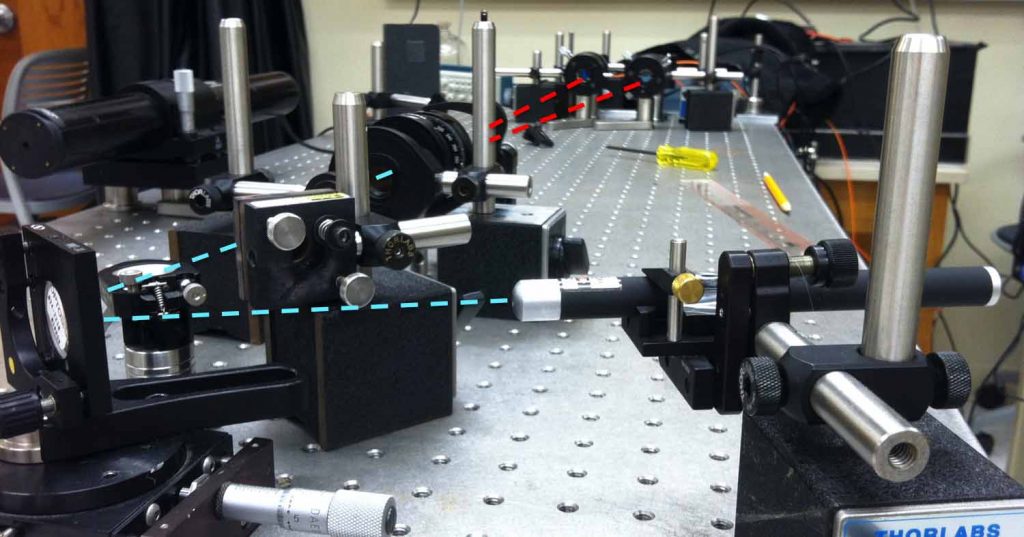
Enrique J. “Kiko” Galvez
Department of Physics and Astronomy
Colgate University
This webpage provides resources for faculty and students for implementing experiments with single photons that illustrate various fundamental aspects of quantum mechanics. The project started in 1999 with a grant from the National Science Foundation and the vision and enthusiasm of a great colleague, Charles H. Holbrow. Along the way we have developed new laboratory experiments, instruction materials and procedures. This page provides all those materials.
Quantum physics embodies a structure to understand the natural world at all scales. It is based on quantum mechanics, arguably one of the most successful physical theories ever invented. Quantum mechanics describes physical phenomena, especially microscopic phenomena, efficiently and successfully. Yet it does so resting on fundamentals that are not easy to understand because they seemingly contradict our everyday experience. One approach to deal with this is to close your eyes and just apply the formalism, get outcomes to compare with measurements. But accepting quantum mechanics also means implicitly accepting those counter-intuitive fundamentals. Why ignore them? Perhaps we can gain a better understanding of nature if we understand quantum mechanics at a fundamental level. We can even ask: is nature really like that? Or is it some quirk of the theory? There is one way to find out: by experimentation, and by asking nature the tough questions. Advances in technology have allowed scientists to ask the tough questions. The answers confirm the theory. This has led us to accept some tough ideas, such as entanglement, nonlocality and indeterminism. They are true because experiments confirm them. Yet, they are hard to accept. Some concepts are challenging. Some renowned scientists may even argue heatedly about what they mean and how we should talk about them. But, philosophy aside, the scientific community has also come to a consensus about how to view them within the context of the theory. So, led by these landmark experiments, we have embarked into this project: to let students see it for themselves, and to struggle with its meaning in the same way scientists and professors do.
This is a project that was initially funded by the National Science Foundation to establish a set of undergraduate laboratories to study the fundamentals of quantum mechanics. The experiments are laboratory exercises on topics of quantum mechanics that are otherwise theoretical, abstract or even unintuitive. The central issue of the experiments is quantum superposition: the ability of a quantum to be in two places at the same time or to be in to be in a correlated superposition of states with other quanta.
Locally, we are committed to this project with an ambitious goal: to implement a laboratory for a course on quantum mechanics. We have been doing so since 2005, but with many changes along the way. Currently, it is a curricular offering. Our most recent teaching materials are posted in this site. Since 2011 we have been offering Alpha Immersions. These are faculty workshops that teach all aspects of the experiments. The experiments and laboratories are well suited for advanced student experiments. We also post instructions so that students can set up the experiments by themselves, doing the alignments and taking data.
The laboratories are based on a source of photon pairs created by the process of spontaneous parametric down-conversion. Many of the experiments explore the physics of a single quantum of light: the photon. Others address more advanced topics that involve 2 photons, such as entanglement. Details of the experiments are contained in the numerous files and postings in this page. Suffices to say that the source is table-top, reliable and of cost that decreases by the day.
Updates:
August 2021: Uploaded 6 data acquisition programs that use the Matlab platform to control the Red Dog data acquisition board. Also uploaded recent publication on a demonstration of QKD with entangled photons published in the American Journal of Physics.
EG
July 2022: Updated and new Matlab programs for Altera and Red Dog boards, fixes bug to do with long and short integration times. Also, added an update for programming Altera DE2-115.
EG